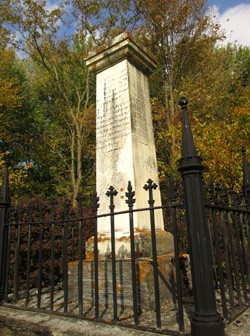
Because something really awesome happened here. Spies! Prison escapes! Duping the British army! And hunkering in a musty root cellar with only shriveled roots to eat for 10 days! It was all to avoid capture as the British raided and burned their way through Addison County, trying to ensure that the Continental Army had no supplies to fall back on when they left.
Somewhere on winding Weybridge Road, in the shadow of Snake Mountain, lurks a dissolving marble, flat-capped column that looks like it ran away from a Middlebury graveyard in the middle of the night. As I stopped at the roadside and walked down the long, straight path, it was eerily still. With the leaves shifting and a morning fog lingering, accompanied only by distant cricket songs, it certainly felt like entering a graveyard.
Except that nobody died here. The town of Weybridge keeps the wide path to this monument mowed, however, so visitors are expected. The overgrown ornamental shrubbery around the site and the black iron fence around the obelisk hints that this place was probably once important.
The monument is dedicated to Carlton’s Raid — named for a cabin-burning British commander — and rather stuffily explains:
Weybridge was chartered by N[ew] H[ampshire] in 1761 and settled in 1775 by Thomas Sandford, David Stow, Justus Sturdevant & Claudius Britell. Nov. 8, 1778, a party of British Torries & Indians destroyed their houses and effects & carried Sandford & son, Robert D. Stow & son, Claudius C. Britell & son & J. Studevant prisons to Quebec. Their wives and children, after occupying a cellar at this place for 10 days, were taken to Pittsford by our troops. D. Stow died in prison Dec. 31 1778. T. Sandford escaped. The others were discharged in 1782.
Erected in 1856 by descendants of the people whose names are carved on it, the monument leaves out all the good parts. Luckily, Middlebury’s Sheldon Museum does not. According to the books Carlton’s Raid by Ida H. and Paul Washington and A History of Weybridge, Vermont by Ida H. Washington, the official story goes like this: Several stubborn families of farmers in Weybridge refused to evacuate to the nearby garrison of Pittsford when news arrived of the impending British invasion.
It’s possible that at least some members of those families were more than just “stubborn.” David Stow and Thomas Sandford were captured on Lake Champlain, miles from home “on a trip to get some lumber.” Strangely, they were sailing near sites occupied by the British when lumber should have been more safely obtainable at any of the neighbors’ abandoned homesteads — and without leaving their families alone in the middle of an invasion. In the middle of a cold November.
Maybe they were just foolish, maybe they’d already scavenged all the nearby wood, or maybe Stow and Sandford were part of the Continental Army’s effort to feed misinformation to the British by seeding men along the way to act as scouts — men who became bogus informants if they were caught and questioned.
Those “informants” must have been amazingly good liars, because the British quickly sent back several boatloads of troops to Québec when Sandford, Stow and others told them they could expect to be greeted by a volley of gunshots from a throng of well-armed Continental soldiers if they continued south. In truth, both supplies and troops were running dangerously short for the revolution and could hardly have defended the nearby fort, let alone the rest of Vermont. But for whatever reason, the British took seriously the colonists’ warnings about the level of resistance they could expect, and sought to cut their losses.
A much smaller invasive force continued onward from the lake into Addison County to attack the remaining inhabitants and trash their farms. But once they caught the males of Weybridge, the British had trouble hanging on to them. First Robert Sandford, who was only 10, collapsed by the roadside after marching for several miles and was abandoned there, left to find his way home. Then 15-year-old Clark Stow was released into the custody of a Québec woman and spent the Revolutionary War as her servant. Next, Thomas Sandford tried to sneak a letter home to his wife, but prison guards confiscated it. He didn’t give up. Sandford escaped when a mass of prisoners tunneled out through the walls one night. After this fiasco, the British moved their feisty captives to a lumber mill in Malbaie.
But this didn’t end the escape attempts.
Claudius Britell, Justus Studevant and others stole a flat-bottomed boat and took off. Unfortunately, they were recaptured. Meanwhile, Sandford wandered for months all across New England, trying to find his way back home. When he finally got there, two of his escaped horses had gone wild, but still recognized him when he called their names. They probably fared better than his farm, which was sold to a family from Connecticut. But Sandford’s fortunes must have recovered somewhat, because 70 years later his descendants were still around to carve the bones of his story into marble.
Outraged, or merely curious, about something? Send your burning question to [email protected].




Comments
Comments are closed.
From 2014-2020, Seven Days allowed readers to comment on all stories posted on our website. While we've appreciated the suggestions and insights, right now Seven Days is prioritizing our core mission — producing high-quality, responsible local journalism — over moderating online debates between readers.
To criticize, correct or praise our reporting, please send us a letter to the editor or send us a tip. We’ll check it out and report the results.
Online comments may return when we have better tech tools for managing them. Thanks for reading.